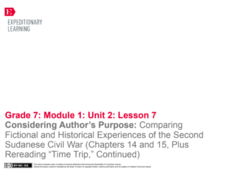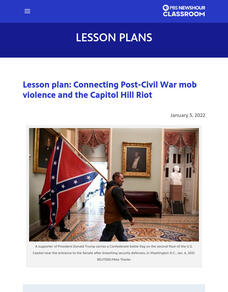Annenberg Foundation
Reconstructing a Nation
Think back to the aftermath of an family dispute. The awkwardness of having to make up, get along, and move forward can be very difficult. The tenth lesson of a 22-part series on American history examines the Reconstruction Era following...
Polk County Public Schools
The Blame Game for the Loss at Pearl Harbor
Known as the day that will live in infamy, the attack on Pearl Harbor in 1941 was a shock to all. But why was the United States unprepared on that December morning? Study a series of primary sources in a document-based question that...
Theodore Roosevelt Association
Defining America's Role in the World
As the first American president to win the Nobel Peace Prize, and only one of four presidents to do so in United States history, Theodore Roosevelt's foreign policy achievements and preservation of peace are often overshadowed by his...
Curated OER
The Pre-Civil War Era (1815–1850)
In this online interactive U.S. history worksheet, students respond to 9 short answer and essay questions about 19th century America. Students may check some of their answers on the interactive worksheet.
Wikipedia
Map of World War II Japanese American Internment Camps
Your learners may be surprised to view the extensive number of Japanese American Internment Camps that existed in the United States during World War II. This map details the area along the Pacific Coast from which people of Japanese...
EngageNY
Comparing Historical and Fictional Accounts: Second Sudanese Civil War (Chapters 14 and 15, Plus Rereading “Time Trip”)
Let's compare! One pair of scholars adds to the Salva/Nya anchor chart by gathering evidence about the characters from chapters 14 and 15 of A Long Walk to Water. The rest of the class pairs work on adding to the Survival anchor chart....
PBS
Connecting Post-Civil War Mob Violence and the Capitol Hill Riot
Anti-democratic violence is not new in the United States. Learners watch videos and then compare and contrast the 1873 Colfax and the 1898 Wilmington massacres. They then watch a video about the Capitol Hill insurrection of 2021 and...
EngageNY
Building Background Knowledge: Guided Practice to Learn about the History of Wars in Vietnam
Scholars use a map of Asia to help them better understand the article "The Vietnam Wars," focusing on word meaning in the title and subtitle. Learners then use guided notes while reading the article and discuss their ideas with partners.
EngageNY
Building Background Knowledge: Small-Group Work to Learn More about the History of Wars in Vietnam
Scholars take a close look at "The Vietnam Wars." They answer questions and discuss in groups to conclude that the author respects the Vietnamese. They participate in a modified jigsaw discussion and end the exercise with a quick writing...
EngageNY
Launching The Performance Task: Building Background Knowledge: “War in the Pacific,” Part 1
It's all about a bit of give and take. Scholars silently read War in the Pacific and circle any unfamiliar words. Using context clues, they write each word on a strip of paper along with the inferred definition. After looking the word up...
EngageNY
Building Background Knowledge: The Dinka and Nuer Tribes Until the Mid-1980s (“Sudanese Tribes Confront Modern War” Excerpt 2)
Scholars continue making connections between the article "Sudanese Tribes Confront Modern War" and A Long Walk to Water by Linda Sue Park. They talk with partners to discuss how the article helps them understand a character's point of...
EngageNY
Considering Author’s Purpose: Comparing Fictional and Historical Experiences of the Second Sudanese Civil War (Chapters 14 and 15, Plus Rereading “Time Trip,” Continued)
Is that a true story? Readers work to gather evidence for comparing the historical and fictional text Time Trip: Sudan’s Civil War and A Long Walk to Water. Scholars identify the use of real people and experiences versus the use of...
EngageNY
Inferring Author’s Opinions and Writing Opinion Statements: Journalists’ Opinions about Segregation Post–World War II (Promises to Keep, Pages 22–25)
Let's play ball! Scholars summarize information from Promises to Keep about segregation in professional baseball after World War II. They then listen as the teacher reads pages 22-25 aloud. Pupils write the gist in their journals of...
Unit III Vietnam War: 1956 to 1963 (2016)
Powerpoint with Essential Questions of Unit III Vietnam War and Peace course, focusing on the transition from Eisenhower to the Kennedy administrations. Students (8-12+) will understand the key geopolitical and internal...
Cuba War and Peace: Essential Questions (2016)
Students (grades 8-12+) will understand the key geopolitical, historical, social and internal dynamics of U.S-Cuba relations, 1895-present. Learners evaluate the role of geography, imperialism, slavery, island ethnicity,...
Cuba War and Peace: Lecture II 1952 to 2015
Students consider the causes and consequences of the Cuban Revolution, including the Batista regime, independence movements of Latin America and Cold War geopolitics. Particular attention is paid to the Eisenhower, Castro, Khrushchev and...
Vietnam War and Peace: Student Learning Outcomes (2016)
Overview of Vietnam War and Peace Unit: students will understand the key geopolitical and internal dynamics shaping Vietnam’s history 1956-1963.
US DBQs European Migration through Civil War
This activity contains DBQs about United States History ranging from the European Migration through the Civil War. All of the documents provided contain primary sources for students to answer as well as an essay to complete once...
Curated OER
My Secret War: The WWII Diary of Madeline Beck: Lesson 6
Fifth graders explore women's rights by discussing the events of WWII. In this American work force lesson, 5th graders identify the events that led to World War II and how women helped fight the war through non-violent efforts. Students...
Curated OER
Hundred Years War and Joan of Arc
Examine the Hundred Years' War. Budding historians view a video on Joan of Arc to discuss her qualities of courage and bravery. They respond to the video and discussion in their journals and write in the perspective of Joan of Arc.
Curated OER
Similarities and Differences Between the American Revolutionary War and the American Civil War
Fifth graders describe three similarities and three differences between the American Revolutionary War and the American Civil War. They play a game comparing the two wars.
Curated OER
Cold War into Guerilla War
Students examine the Cold War and the War on Terror. In this American history lesson, students research print and nonprint resources regarding both wars. Student compare the experiences of youth at the time so both the Cold War and...
Curated OER
From Korea to Vietnam: America Changes Her View on War
Eleventh graders identify and analyze the differences between the Korean and the Vietnam Wars. In small groups they conduct research and create a scene from a movie that focuses on the Korean or Vietnam War. Students view and evaluate...
Curated OER
World War II: Causes and Consequences
Tenth graders examine Hitler's occupation of Europe and the Allies' efforts to fight it. In this World War II lesson, 10th graders examine how World War II changed American society, especially for women. Students analyze a...
Other popular searches
- Star Wars
- Napoleonic Wars
- Punic Wars
- Star Wars Archetypes
- Star Wars Mythology
- American Wars
- Star Wars Vocabulary
- Persian Wars
- Star Wars Lesson Plans
- Star Wars Movie
- Star Wars Music
- Star Wars Media Studies

























